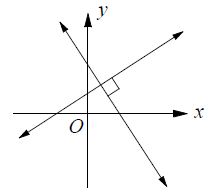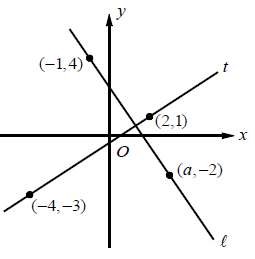SLOPES OF PARALLEL AND PERPENDICULAR LINES
Subscribe to our ▶️ YouTube channel 🔴 for the latest videos, updates, and tips.
Parallel lines :
Parallel lines will have the same slope.

If m1 and m2 are slopes of the 1st and 2nd line, then
m1 = m2
Perpendicular Lines :
Lines that intersect at right angles are called perpendicular lines.
If the product of the slopes of two nonvertical lines is -1, then the lines are perpendicular

Problem 1 :
In the xy plane, the lines
y = mx - 7 are 2x + 3y = 6
are parallel. What is the value of m ?
Solution :
Slope of the line y = mx - 7 :
By comparing the given equation with slope intercept form
y = mx + b
m1 = m
Slope of the line 2x + 3y = 6 :
3y = -2x + 6
Dividing by 3 on both sides.
y = (-2/3) x + (6/3)
y = (-2/3) x + 2
m2 = -2/3
Since the given lines are parallel,
m1 = m2
m = -2/3
Problem 2 :
A line passes through the points (-1, 2) and (5, b) and is parallel to the graph of the equation 4x - 2y = 13. What is the value of b ?
Solution :
Slope of the line joining the points (-1, 2) and (5, b).
m = (y2 - y1) / (x2 - x1)
m1 = (b - 2) / (5 + 1)
m1 = (b - 2) / 6 ---(1)
4x - 2y = 13
2y = 4x - 13
Dividing by 2 on both sides.
y = (4x/2) - (13/2)
y = 2x - (13/2)
m2 = 2 ----(2)
(1) = (2)
(b - 2) / 6 = 2
Multiply by 6 on both sides.
b - 2 = 12
Add 2 on both sides.
b = 12 + 2
b = 14
Problem 3 :

In the xy - plane above, line l is parallel to line m. What is the value of b?
Solution :
The line (m) passes through the points (-1, -3) and (-4, b)
The line (l) passes through the points (2, 0) and (0, 3)
m = (y2 - y1)/(x2 -x1)
|
Slope of the line m : m1 = (b + 3) / (-4 + 1) m1 = (b + 3) / (-3) ----(1) |
Slope of the line l : m2 = (3 - 0) / (0 - 2) m2 = -3/2 ----(2) |
Since the lines are parallel m1 = m2
(b + 3) / (-3) = -3/2
Doing cross multiplication, we get
2(b + 3) = -3(-3)
2b + 6 = 9
2b = 9 - 6
2b = 3
Dividing by 2 on both sides.
b = 3/2
Problem 4 :

In the xy-plane above, if line l is perpendicular to line t, what is the value of a?
Solution :
The line (t) passes through the points (-4, -3) and (2, 1).
The line (l) passes through the points (a, -2) and (-1, 4).
Slope (m) = (y2 - y1) / (x2 - x1)
|
(-4, -3) and (2, 1) m1 = (1 - (-3)) / (2 - (-4)) m1 = (1 + 3) / (2 + 4) m1 = 4 / 6 m1 = 2/3 |
(a, -2) and (-1, 4) m2 = (4 - (-2)) / (-1 - a) m2 = (4 + 2) / (-1 + a) m2 = 6 / (a - 1) |
2/3 = 6/(a - 1)
Doing cross multiplication, we get
2(a - 1) = 6(3)
2a - 2 = 18
Add 2 on both sides.
2a = 20
a = 10
Problem 5 :
kx - 3y = 4
4x - 5y = 7
In the system of equation above, k is constant and x and y are variables. For what value of k will the system of equation have no soltuion ?
a) 12/5 b) 16/7 c) -16/7 d) -12/5
Solution :
kx - 3y = 4 ----(1)
4x - 5y = 7 ----(2)
Finding slope and y-intercepts from the lines. From (1)
3y = kx + 4
y = (k/3) x + 4/3
Slope = k/3 and y-intercept = 4/3
From (2),
5y = 4x + 7
y = (4/5) x + (7/5)
Slope = 4/5 and y-intercept = 7/5
Since the system has no solutions, the linear equations will be parallel, then their slopes will be equal.
k/3 = 4/5
k = 4(3)/5
k = 12/5
So, option a is correct.
Problem 6 :
(3/2)y - (1/4)x = 2/3 - (3/2)y
(1/2)x + 3/2 = py + (9/2)
In the given system of equation p is constant. If the system has no solution. What is the value of p ?
Solution :
(3/2)y - (1/4)x = 2/3 - (3/2)y
(3/2)y + (3/2)y = 2/3 + (1/4)x
(6/2)y = (1/4)x + 2/3
3y = (1/4)x + 2/3
y = (1/12) x + 2/9
Slope = 1/12 and y-intercept = 2/9
(1/2)x + 3/2 = py + (9/2)
py = (1/2)x + (3/2) - (9/2)
py = (1/2)x - (6/2)
py = (1/2)x - 3
y = (1/2p) x - (3/p)
Slope = 1/2p and y-intercept = -3/p
1/12 = 1/2p
2p = 12
p = 12/2
p = 6
So, the value of p is 6.
Subscribe to our ▶️ YouTube channel 🔴 for the latest videos, updates, and tips.
Recent Articles
-
Finding Range of Values Inequality Problems
May 21, 24 08:51 PM
Finding Range of Values Inequality Problems -
Solving Two Step Inequality Word Problems
May 21, 24 08:51 AM
Solving Two Step Inequality Word Problems -
Exponential Function Context and Data Modeling
May 20, 24 10:45 PM
Exponential Function Context and Data Modeling